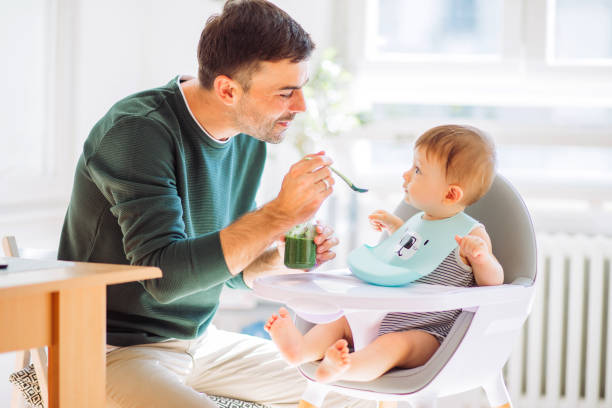Baby skin care: While your baby’s skin feels oh-so-soft and delicate, it can also be prone to bumps, rashes, and other surprises. But fear not! Most are harmless and disappear on their own. With a little knowledge, you can soothe your baby’s discomfort and keep their skin healthy and happy.
Rashes, bumps, and spots

The tender and soft skin of a baby is a unique experience. However, it’s not uncommon for infants to experience irritations like diaper rash or cradle cap, leading to a fussy baby. Despite your baby being perfect, their skin might face challenges. Most baby rashes, like diaper rash or cradle cap, clear up on their own. In the initial months, many babies are susceptible to skin issues. Here’s how you can address them.
The majority of baby rashes are harmless and typically resolve without intervention. Baby skin care may appear daunting, but it boils down to understanding three fundamental aspects:
- Conditions you can address at home.
- Issues requiring medical treatment.
- Preventive measures to avoid skin problems.
Prevent Diaper Rash
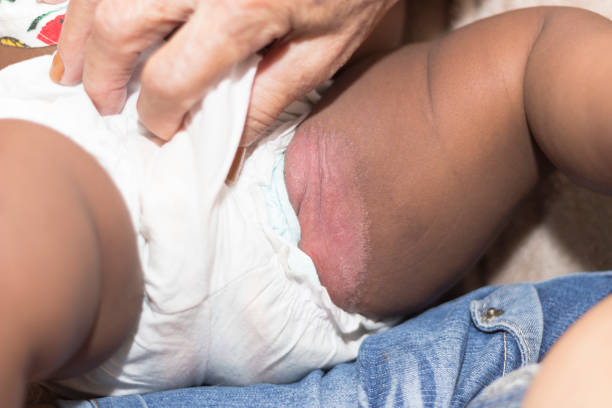
When you notice redness in the diaper region of your baby, it’s likely diaper rash. This often occurs due to skin irritation caused by:
- Tight diapers
- Prolonged use of wet diapers
- Certain detergents, diaper brands, or baby wipes
To steer clear of diaper rash:
- Allow the diaper area to be exposed to air whenever possible
- Change your baby’s diaper promptly when it’s wet If diaper rash appears, cleanse it with a warm cloth and apply zinc oxide cream.
Pimples & Whiteheads

Baby “acne” differs from teenage acne, and research indicates it might be linked to yeast rather than oil. Pimples appearing on a baby’s nose and cheeks typically resolve on their own within a few weeks. There’s generally no need for treatment or the application of lotions.
Birthmarks
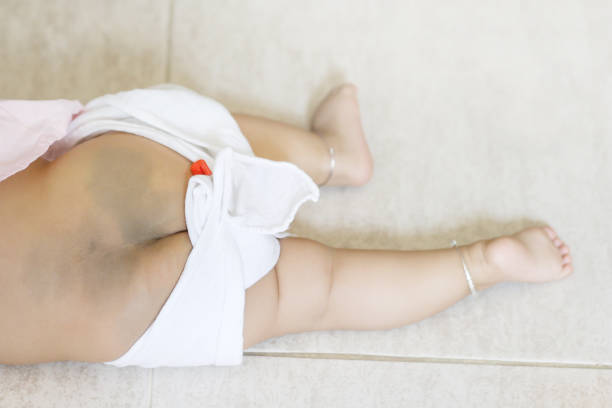
Many babies, over 1 in 10, develop birthmarks—areas of skin discoloration. Birthmarks are not inherited and can be present at birth or appear in the following months. In most cases, birthmarks are harmless and require no treatment. However, if you have concerns about your baby’s birthmark, it’s advisable to discuss them with your pediatrician.
Eczema

Eczema is an itchy, red rash that can occur in response to various triggers. It is common in children with a family history of asthma, allergies, or atopic dermatitis. The rash may initially appear weepy on your baby’s face and later become thick, dry, and scaly. Eczema can also manifest on the elbows, chest, arms, or behind the knees. Treatment involves identifying and avoiding triggers, using gentle soaps and detergents, and applying moderate amounts of moisturizers. Severe cases may require prescription medicine.
Dry Skin
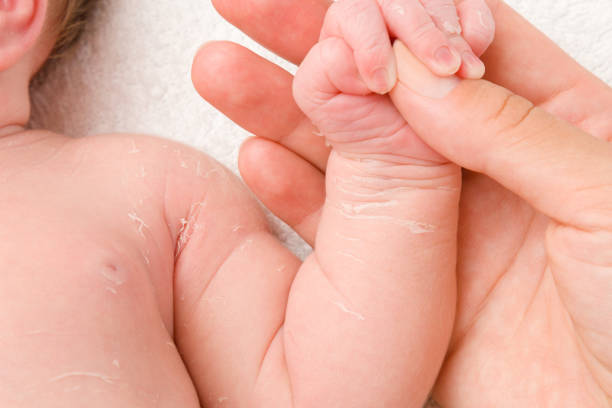
Peeling and dry skin in newborns is a common occurrence, especially if your baby is born a little late. The underlying skin is generally healthy, soft, and moist. If your baby’s dry skin persists, it’s advisable to consult with your baby’s pediatrician.
Greasy Scalp, Don’t Panic: Tackling Cradle Cap in Babies
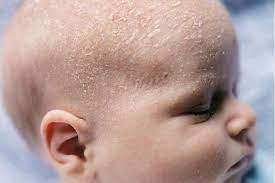
Cradle cap can appear in a baby’s first or second month and typically resolves within the first year. Also known as seborrheic dermatitis, it occurs due to an excess of oil. The condition manifests as a scaly, waxy, red rash on the scalp, eyebrows, eyelids, the sides of the nose, or behind the ears. Your pediatrician will provide recommendations for the best treatment, which may include a special shampoo, baby oil, or specific creams and lotions.
Prickly Heat

Prickly heat manifests as small pinkish-red bumps and typically appears in areas prone to sweating, such as the neck, diaper area, armpits, and skin folds. Treating it involves creating a cool, dry environment and dressing your baby in loose-fitting clothes. It’s essential to note that prickly heat can occur even in winter when a baby is over-bundled, so consider dressing them in layers that can be removed when it gets warmer.
Yellow Skin (Can Mean Jaundice)

Jaundice is a yellow discoloration of a baby’s skin and eyes. It typically appears 2 or 3 days after birth and is more common in premature babies. It results from an excess of bilirubin, a breakdown product of red blood cells. Jaundice usually resolves by the time a baby is 1-2 weeks old. Treatment may involve more frequent feedings or, in more severe cases, light therapy (phototherapy). If your baby appears yellow, consult your doctor.
White Bumps (Milia)
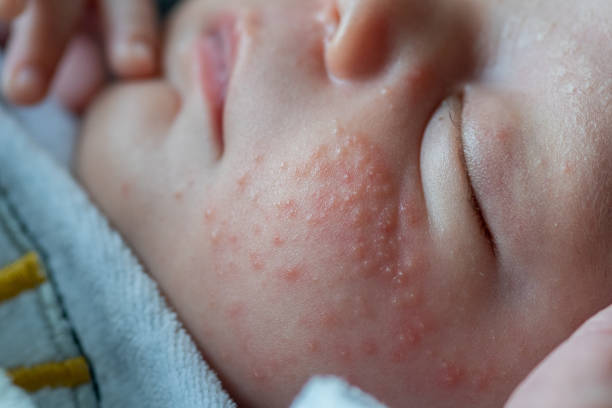
Milia are small, hard, white bumps that can appear on the skin. They commonly occur on the faces of infants and adults but can emerge on any part of the body. While they are painless and harmless, milia may naturally go away in infants, but older individuals might require surgical or medical treatment for their removal.
Baby Yeast Infections
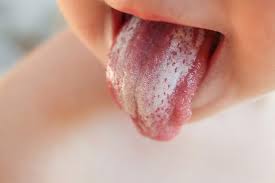
These infections often occur after your baby has taken a course of antibiotics. Their appearance varies based on the affected area. Thrush manifests on the tongue and mouth, resembling dried milk. A yeast diaper rash presents as a bright red rash, often with small red pimples at the edges. Consult your pediatrician: Thrush is treated with an anti-yeast liquid medicine, while a yeast diaper rash is addressed with an antifungal cream.
Infant Sunburn
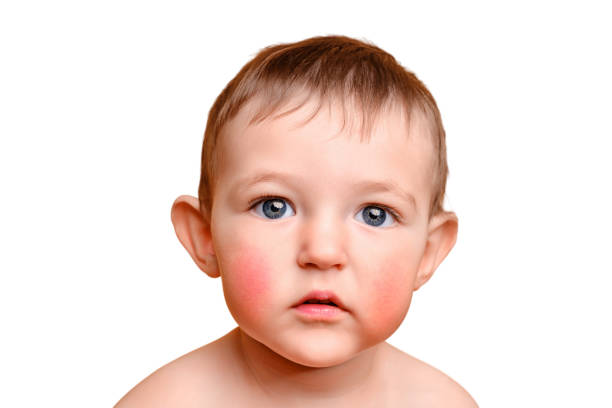
While the sun may feel pleasant, it can put your baby’s skin at risk of sunburn. You can use baby sunscreen on infants at any age, and hats and umbrellas provide additional protection. However, for the best defense against sunburn, avoid exposing your infant to direct sunlight during the first 6 months of life. If your baby experiences mild sunburn, apply a cool cloth to their skin for 10-15 minutes a few times daily. For more severe sunburn, contact your child’s pediatrician.
Baby skin care : Prevention is the key
Powdering ( not needed for Infant Skin )
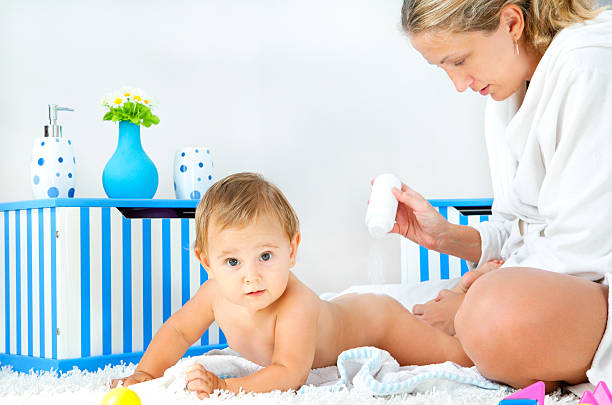
It’s advisable to refrain from using talcum powder or cornstarch on your infant’s skin. Babies can inhale the fine grains of talcum powder or the larger particles of cornstarch, which may lead to lung problems. Therefore, it’s best to avoid using these products on your baby.
Laundry
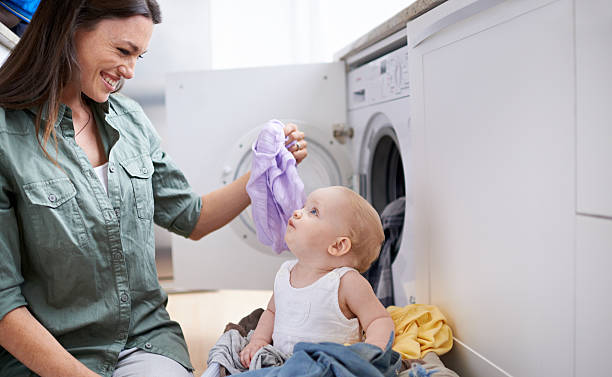
Keep your baby smiling and happy by preventing skin rashes. Use a mild detergent to wash everything that comes into contact with your infant’s skin, including bedding, blankets, towels, and even your clothes. This will reduce the chances of itching or irritation.
Baby Sunscreen

Safeguard the areas of your baby’s skin that can’t be shielded by clothing by applying sunscreen. Utilize zinc oxide on your baby’s nose, ears, and lips. Dress your baby in clothes and a wide-brimmed hat to cover the remaining skin. Sunglasses are essential to protect your child’s eyes from harmful rays.
Baby Skin Care Products

When shopping for baby skin care products, remember that less is more. Opt for items without dyes, fragrances, phthalates, and parabens to avoid potential skin irritation. If unsure, consult with your pediatrician to ensure a product is suitable for your baby.
Bath Time
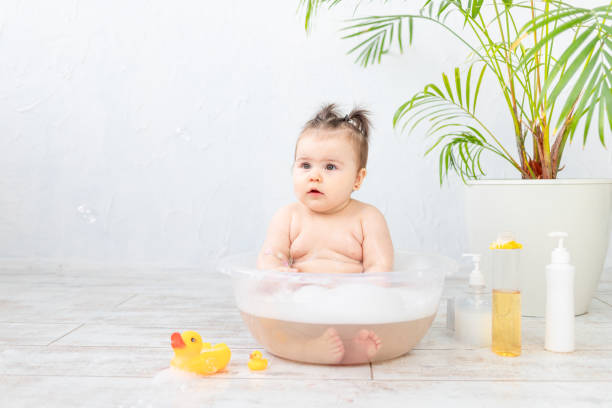
Newborn skin is soft and sensitive, so be gentle during bath time. Limit baths to 3 to 5 minutes in warm water, avoiding prolonged exposure to soapy water. After the bath, apply a baby lotion or moisturizer while their skin is still wet, and pat dry instead of rubbing. If your newborn’s umbilical cord hasn’t fallen off, opt for a sponge bath. Keep your baby comfortable and hydrated to prevent skin issues.
Baby Massage
Ease your baby’s irritability caused by rashes or skin conditions with gentle baby massage. Stroking and massaging your baby’s skin not only promote relaxation but can also improve sleep and help reduce or eliminate crying.
Call Your Pediatrician If:
Your baby’s skin shows small, red-purplish dots, yellow fluid-filled bumps, or if your baby has a fever, appears drowsy, or is sluggish, it’s crucial to consult your pediatrician promptly. However, most baby skin rashes and problems are not serious, some may indicate infection and require close attention

